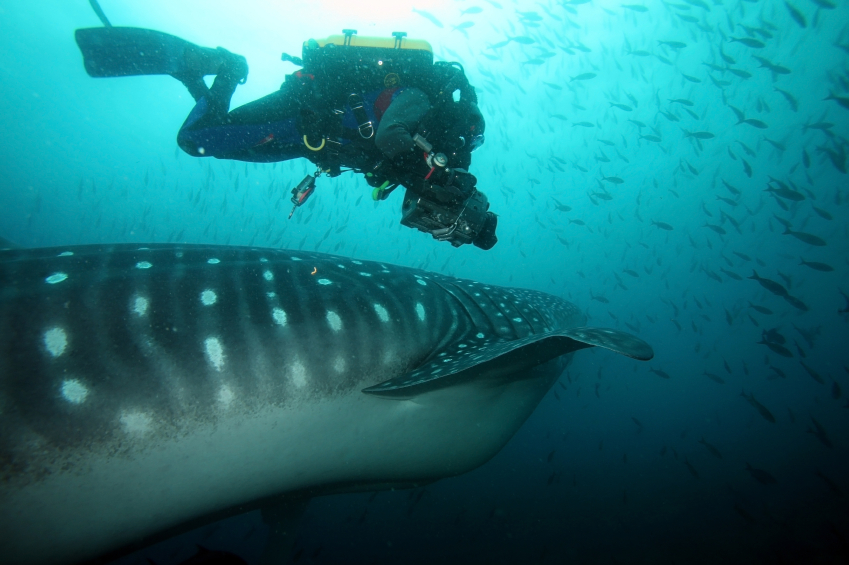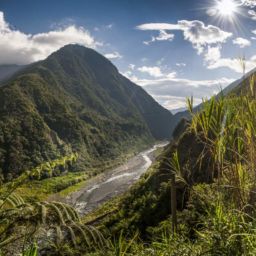Okay, yes I know that last part is vastly oversimplified, but you get my drift. The Galapagos is pretty amazing and a bucket list without it wouldn’t be a bucket list worthy of mentioning.
These secluded little islands are about 500 miles off coast of Ecuador and consist of 13 major islands, only 5 of which are inhabited. A couple of those islands are so young they’re actually still being formed by active volcanoes. So yeah, there’s that too.
One of the things that contributes to the richness of this archipelago are the varied oceanic currents that meet there and create a mix of warm and cold water with upwellings. Unrivaled in the world for unique and diverse life, the seclusion, temperate weather, and converging currents in the Galapagos create a home for large schools of sharks and rays, whales, and endemic marine and terrestrial life. Turtles, iguanas, whales, sharks, seals, and penguins… the Galapagos has it all and then some.
When to go
Generally speaking, from May to November the Humboldt current brings cooler water (60-75 degrees) rich with nutrients and with it whales and whale sharks. Melon headed, humpback, and pilot whales on migration pass through the area each season following their food source. June to September is the “tourist” season for that very reason, and getting spots can be difficult at the last minute, so plan ahead. The Galapagos is a World Heritage site and is highly protected and regulated, they only allow a certain number of visitors into the area at any one time.

In addition to the whales, the influx of fish brings birds such as penguins and albatrosses, and June/July is the mating season for both the owls and the blue footed boobies. (Yes, I did just say boobies). The downside to this time of year is the rougher seas, colder water, and colder weather. Plan to wear a 7mm and expect chillier (not cold), overcast, windier days above water. If you get seasick easily, plan for that.
The other half of the year, December until May, both the water and air is a little warmer, the seas are a little calmer, but it rains a lot more since this is the rainy season. Mostly a drizzle, though it’s near constant. Sea Lions mate this time of year and it’s possible to see some pups in March or April. Sea turtles begin nesting now, and the land tortoises begin their mating rituals in March. In March and April, the island becomes flooded with colors as the flowers bloom and the rainy skies begin to clear.
Where to go
Let’s start with diving since that’s what we’re all reading this for, right?
Wolf and Darwin Islands are at the top of the list due to being considered one of the best diving sites on the planet. Whale sharks, hammerheads, trumpet fish, amberjacks, butterfly fish, parrot fish, tuna, and rays are just a sampling of the array of finned creatures you’ll see at these feeding and cleaning stations. The dives are 40 – 90 feet with 1-3 knot currents. Keep an eye out for orcas, seals, sea lions, and turtles too. These are the two top spots for a plethora of large marine life.
If you’re looking for a wall dive, Cousins Rocks is the place for you. Walls and slopes from 20 to 100 feet display black coral with sea turtles and the largest sea horse in the Pacific. Also nearby, you’ll probably see schools of hammerheads, eagle rays, and barracuda. Don’t forget about the sea lions and fur seals often seen playing together!
Isabela Island is next on the list, an active volcano and home to Galapagos sharks, rays, batfish, lobsters and penguins. On this 20 – 90 ft dive you can also see the gases rising from the volcano.
For the novice divers among us, head to Sante Fe and Floreana Islands where the water is milder and clearer. There are a handful of other dive sites around the islands, but I think you get the idea. Reefs, walls, shallow or deep, you’re going to see more marine life here than you can shake a camera at.
Interesting note: The water around the Galapagos is about 6% saltier than most water, so you’ll need more weight when diving there!
As far as land based options go, they are many. Each island has it’s own animals, views, and charm. Bartholomew boasts a unique lunar landscape with one of the best views in all of the Galapagos, a moderate/difficult 1.2 mile walk up to the top of the volcano, snorkeling, penguins, rays and fish. On Plaza Island you can see iguanas, sea lions, boobies, and a high cliff landscape on the 1.5 mile trail walk. There’s more snorkeling to be done at North Seymour as well as another 1.5 mile hike to see iguanas, boobies, and sea lions. On the far south side of the islands, Santa Maria, or Floreana, has the famous Post Office Bay and Devil’s Crown, an underwater volcanic cone where you can snorkel with sharks, turtles, and sea lions. This island also has an interesting history. Two trails on Santa Fe island give you views of prickly pear cactus forests, scenic cliff views, and a picturesque bay. I use the word “picturesque” as if that makes it unique, but in the Galapagos I think everything must be picturesque! If lava tunnels interest you, then head to Santa Cruz Island where you can take an easy walk through them. Also on Santa Cruz are a lot of endemic plants, a large crater, white sand beaches, and some incredible views of the entire archipelago.
How to go
Liveaboards are the way to see the Galapagos, but they do offer some day trips. Some of the dive sites, such as Wolf and Darwin, can’t be accessed during a day trip though. And much to my surprise, there is actually an airport on Baltra Island, just off the coast of Santa Cruz. It’s a small airport, so you will fly into the Ecuador mainland and then take a smaller shuttle plane to Baltra regardless of whether you choose a liveaboard or day trips.
Who should go
For diving, the Galapagos is not for the new or novice, or the easily seasick. There are stark thermoclines that take you through drastic temperature fluctuations and some sites can have strong currents and surges. For snorkeling or land trips, it’s good for anyone and recommended for everyone.
Final Notes
There’s something here for everyone and I can’t imagine a “bad” dive in the Galapagos. While diving there is most certainly the biggest draw, I don’t think a Galapagos trip would be complete without setting foot on at least one or two of the islands to take in the unique, endemic flora and fauna. Personally, I’d want to see as much above the water as below! And that diversity of scenery and wildlife both marine and terrestrial is what lands the Galapagos in the top 15 of my Diving Bucket List.




